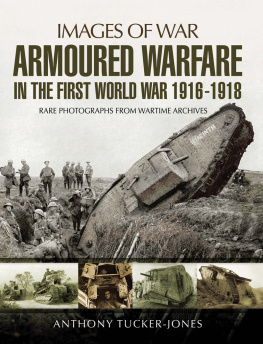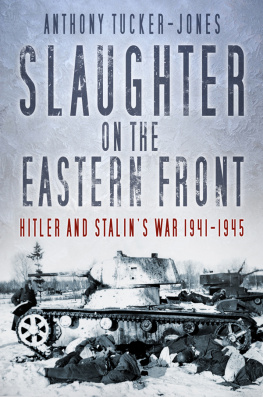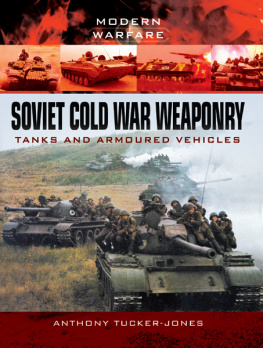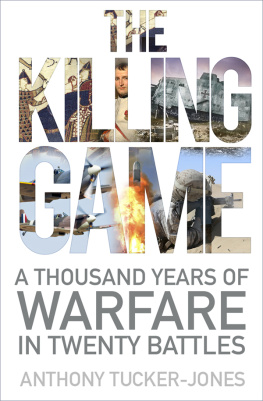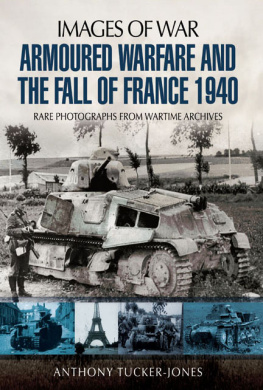
British troops gather around their supporting tank it was designed to cross trenches and break the deadlock on the Western Front.
IMAGES OF WAR
ARMOURED WARFARE
IN THE
FIRST WORLD WAR
19161918
RARE PHOTOGRAPHS FROM WARTIME ARCHIVES
Anthony Tucker-Jones
First published in Great Britain in 2016 by
PEN & SWORD MILITARY
an imprint of
Pen & Sword Books Ltd,
47 Church Street,
Barnsley,
South Yorkshire
S70 2AS
Text copyright Anthony Tucker-Jones, 2016
Photographs copyright as credited, 2016
Every effort has been made to trace the copyright of all the photographs.
If there are unintentional omissions, please contact the publisher in writing, who will correct all subsequent editions.
A CIP record for this book is available from the British Library.
ISBN 978 147387 298 1
eISBN 978 147387 300 1
Mobi ISBN 978 147387 299 8
The right of Anthony Tucker-Jones to be identified as Author of this Work has been asserted by him in accordance with the Copyright, designs and Patents Act 1988.
All rights reserved. No part of this book may be reproduced or transmitted in any form or by any means, electronic or mechanical including photocopying, recording or by any information storage and retrieval system, without permission from the Publisher in writing.
Pen & Sword Books Ltd incorporates the imprints of Pen & Sword Archaeology, Atlas, Aviation, Battleground, Discovery, Family History, History, Maritime, Military, Naval, Politics, Railways, Select, Social History, Transport, True Crime, Claymore Press, Frontline Books, Leo Cooper, Praetorian Press, Remember When, Seaforth Publishing and Wharncliffe.
For a complete list of Pen & Sword titles please contact
Pen & Sword Books Limited
47 Church Street, Barnsley, South Yorkshire, S70 2AS, England
E-mail:
Website: www.pen-and-sword.co.uk
Introduction:
Germanys Downfall
T he story of the creation of the tank is one of pioneering innovation, frustrated military aspirations and lost opportunities. At the time, rather surprisingly, it did not lead to an arms race because the other side chose to ignore it. What follows is designed to provide both a visual guide and brief assessment of the birth of modern armoured warfare. Despite contributing to the defeat of Imperial Germany in 1918, the latter ironically sowed the seeds for the Nazi concept of Blitzkrieg. Although the Battle of Cambrai is held up as the very first tank battle this is in fact a myth, as tanks had already fought at Flers-Courcelette during the Somme offensive, Arras, Passchendaele and Berry-au-Bac. Nor was it the largest tank battle, as the Allied sledgehammer assault at Amiens involved far greater numbers.
The tank concept was developed as a solution to the dreadful impasse that developed on the Western Front during the First World War. British innovation was driven by the need to overcome enemy trenches and strongpoints: indeed by the time the Germans developed their own tanks the first tank-to-tank actions were but a footnote to the conflict.
Although the origins of modern armoured and mechanized warfare date from the First World War, it was not an easy birth. Britain, France and Germany developed armoured fighting vehicles that universally became known as the tank to help break the deadlock of trench warfare. The British and French easily led the way as the Germans were well behind the curve. Getting the balance of power-to-weight ratio and armament just right proved to be a very tricky and often deadly business. Apart from the British Whippet and the French FT all the tanks of this period were little more than lumbering landlocked battleships. Nonetheless, their use at Cambrai and Amiens showed the way ahead.
Essentially First World War British heavy tanks were designed as a breakthrough weapon akin to the later heavy German Tiger and Soviet KV tanks of the Second World War. It was the French who subsequently ran with the concept of a light tank during the First World War intended to exploit a breakthrough. Both British heavy and French light tanks achieved mixed results during 191618 but they laid the foundations for all future armoured and mechanized warfare.
Throughout history cavalry had played an often decisive part in battle by combining mobility, protection and offensive power. They regularly brought terror to the enemy by turning a flank, exploiting a breakthrough and by pursuing a demoralized and defeated army. Led by noblemen and gentlemen, the thrill was in the chase. Eventually improvements in firearms technology inevitably meant that the weight of the fighting always rested on the infantry. In the aftermath of the Napoleonic Wars the introduction of the rifle gave the infantry a weapon with a range of 1,000 yards that spelt the end of the cavalry charge. Likewise the evolution of artillery and artillery tactics changed how cavalry were used.
By the time of the American Civil War cavalry were increasingly being employed as mounted infantry or dragoons. Europe learned the hard way during the Franco-Prussian War that the cavalry charge was now all but redundant in the face of devastating firepower. Similarly the British Army also learned the same lesson in South Africa during the Boer War. Mounted Boer riflemen easily outfought British cavalry who persisted in keeping the lance and sabre. It was only when the British deployed large numbers of mounted units which fought dismounted that the Boers were finally defeated. At the beginning of the First World War such lessons were largely ignored across much of Europe.
On the eve of war Europe was still hopelessly in love with the glamour and dash of the cavalry. It was a career that appealed to many of Europes aristocracy. On the Western Front some ten French and one British cavalry divisions found themselves confronted by a similar number of German cavalry divisions. Initially, as a result of the Schlieffen Plan, the war was very fluid with the German armies swinging rapidly through Belgium. Very briefly the cavalry and horse artillery had their moment of glory.
Once the German advance had been stopped on the Aisne, the fighting took on a completely different complexion. The cavalry became separated and hemmed in by vast trench systems that they were powerless to prevent being constructed. Again the generals failed to appreciate that the need was for mobile mounted riflemen, not old-style European cavalry still brandishing the lance and sabre as if it were yesteryear.
Cavalry became useless and infantry assaults supported by massive artillery bombardments the order of the day. The battlefield was churned up and shorn of all vegetation turning it into a desolate lunar like landscape. Once the rains came the area between the opposing trenches turned into a sea of mud and became called No Mans Land for good reason. Both the British and French generals decided that attack was the best form of defence and proceeded to fight a war of attrition against the German defences. Their aim was to wear Germany down no matter the appalling cost in human lives.
In 1915 both sides tried to break the deadlock by resorting to poison gas. The Germans first used it at the Second Battle of Ypres when they gassed the British in the Ypres Salient. The British then employed it during the Battle of Loos. It proved not to be a decisive weapon and simply added to the suffering and misery of those in the trenches. Both sides quickly learned how to cope with this new horror. By 1916 there was deadlock and in desperation the British and the French began secretly developing the tank in an effort to break through on the Somme.

